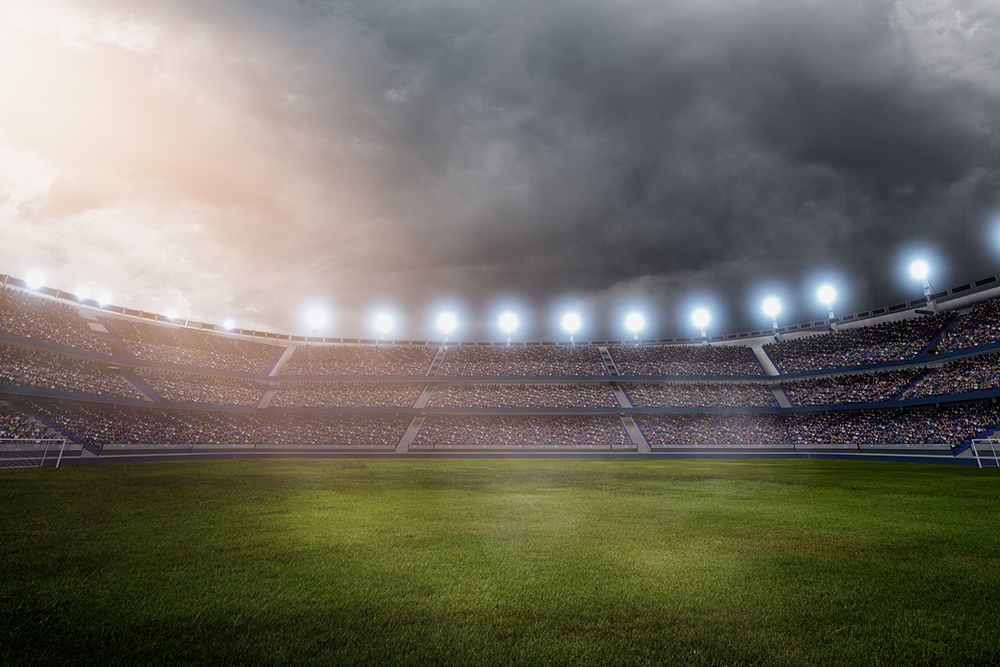According to the HX Study conducted by Starcom and Publicis Groupe’s Data Science department, 74% of Poles watched this year’s European Football Championship, which is in line with official data reported by Nielsen, where the reach of the entire championship in the All 18+ group was 72.3%, and significantly exceeds the declarations from the pre-test of the study, where only 54% of respondents said they would follow the upcoming games.
This year’s championship was a long-awaited sporting event, postponed for a year and starting at a time when the mood of pandemic anxiety was slowly subsiding. The number of cases was falling, vaccines were already widely available, so the public mood was beginning to be more optimistic. We were interested in the current needs of fans and to what extent they were thirsty both for the games themselves and for meetings with friends, and what joint cheering would look like in this unusual year.
Even after the games had started there were voices saying that the atmosphere of this year’s Euro was noticeably different from the previous ones. Changed by the time of the pandemic, fans experienced emotions differently, or perhaps their attitude to different areas changed to such an extent that the European Football Championship was lower on the list of life priorities.
Falling audience
Following the viewing reports, there is a long-term decline in the number of viewers of major football events. This year’s Euro saw a 17% smaller audience vs Euro 2016. Declines are also affecting the Champions League, which is losing viewers year on year, with a 26% drop in viewership in 2021 vs 2018. The exception is the Leage Championships in 2020, where, due to a pandemic year and shifts in the competition, cumulative viewership was higher than in previous years.

We compared the viewing figures of similar matches over several years, which allowed us to confirm the downward trend. The matches involving Poles in the group phase, which attracted an average audience of 15.3 million during Euro 2016, have attracted only 10.9 million viewers during Euro 2020. The final match was also part of the overall declines.
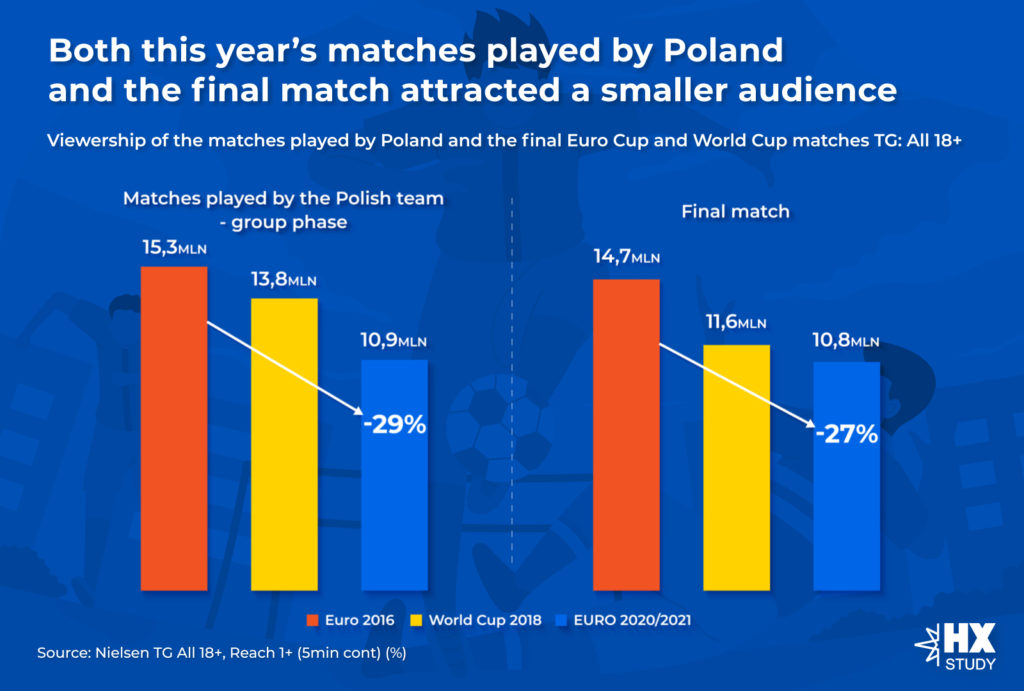
Have viewers switched to the internet?
Since there have been significant declines in TV viewing figures this year, have Poles changed the channels they watch the broadcasts on or is their interest in the championships simply waning?
We have checked on which medium Poles were following the games. TV is the clear leader, but every fifth Pole used a special application that allowed them to follow the broadcasts on phone, computer or smart TV.
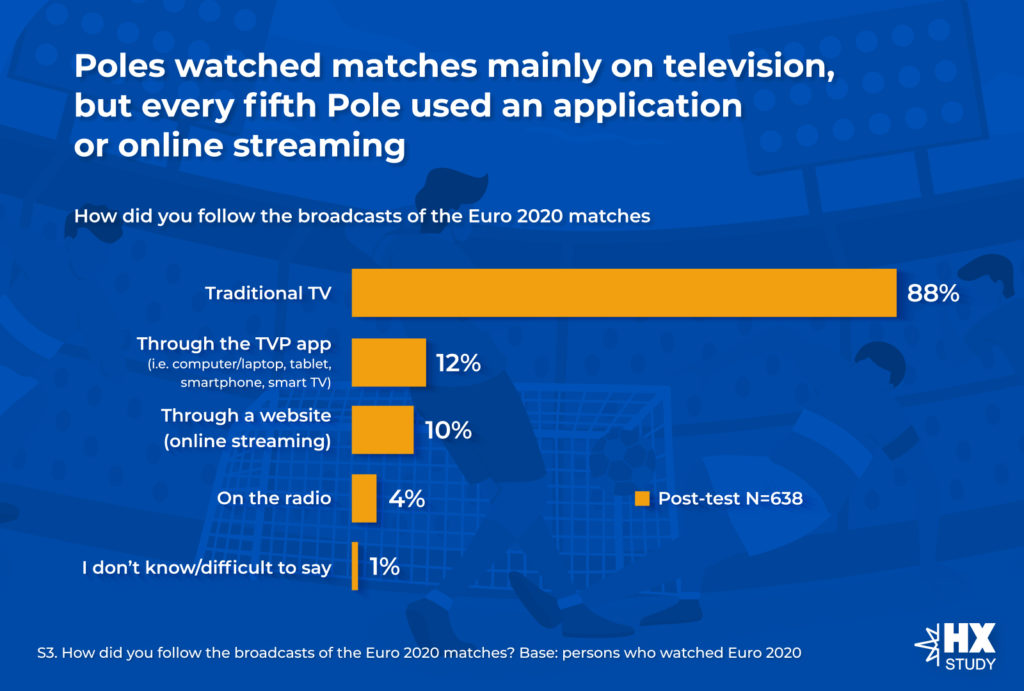
Undoubtedly, the mobile application, which made it possible to watch the European Championships on mobile phones, recorded an increase in users, but the number of all RU aged 18+ oscillated around 800 thousand during the entire championships. On a daily basis, it was used by approximately 200 thousand people. This is a very interesting alternative to linear TV, but it is not a result that would compensate for the loss of the TV audience. Another place where viewers could follow the matches was streaming on the TVP website. However, even the combined number of app users, streaming and traditional TV viewers, is far from the results of previous years. The audience is shrinking and we forecast this trend to continue in the coming years.
We also see that the fan has divided attention. Every 5th person following the European Championship was simultaneously using social media, surfing the Internet, talking on the phone or using instant messaging. Watching videos on YouTube or shopping online were also mentioned as accompanying activities.
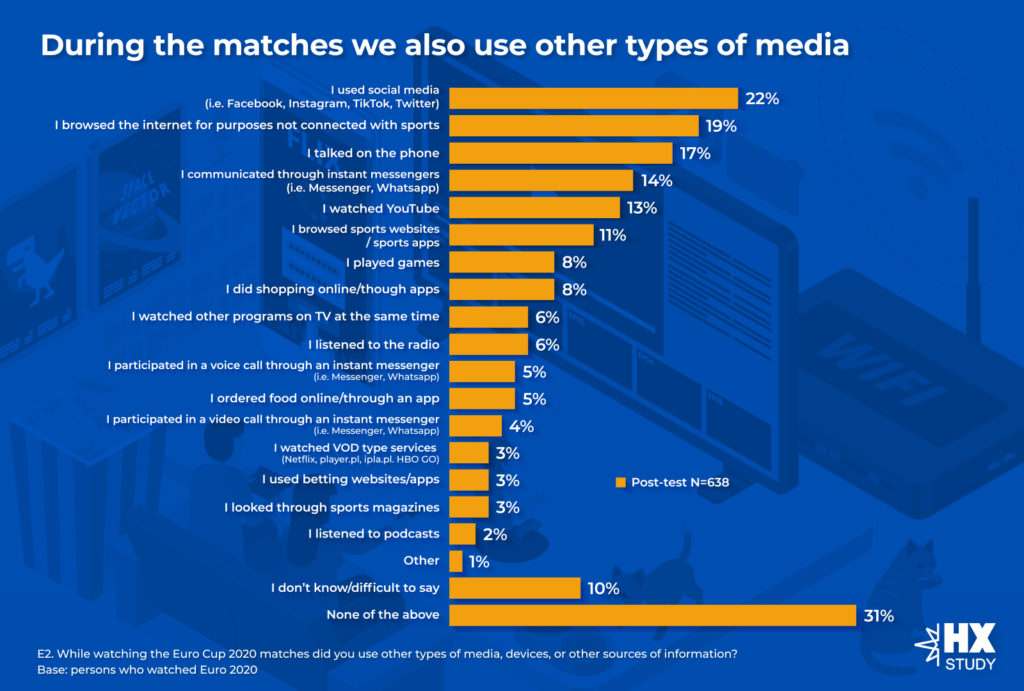
Such indications only confirm the progressive multisceening, i.e. using more than one screen at a time.
In turn, during the championships, sports websites recorded a 38% increase in the average number of real users compared to May 2021. On average, websites were visited by 5.2 million RU daily. The websites and applications enjoyed the greatest popularity during the games of the Polish national team and in the days following them. The number of visitors amounted to 6.8 million. Users read commentaries and match summaries, watched replays of the best moments.
What the fans remember – the knowledge of sponsors
Sports events of this format would not take place without the involvement of sponsors, thanks to whom a tournament organized on such a grand scale had a chance to be carried out at all. We asked respondents about their awareness of sponsor brands in two waves of the survey, before and after the games.
The results show that awareness of most brands that were sponsors of the championships has increased significantly. There were also brands which did not sponsor Euro 2020, e.g. Visa or Orlen. This is probably the effect of long-term partnerships and sponsorship campaigns. The number of false indications decreased after the tournament.

The most frequently indicated brands as Euro 2020 sponsors are Coca-Cola, Tik Tok and Heineken. Tik Tok received the largest increase in indications compared to the pre-test phase. The high position of Coca-Cola and Heineken results both from brand recognition and their long-standing involvement in the sponsorship of many sporting events. We asked Marlena Krąpiec, brand manager for Heineken, for a comment.
Heineken’s campaigns have been accompanying fans during matches of their favourite football teams for years, but what is important, they always surprise with novelty and freshness. While in this year’s campaigns, most brands focused on communicating joint support for the favourite team, Heineken went a step further and inspired solidarity and support for each team, believing that it is the rivalry that makes soccer exciting.
The distance, fresh perspective and sense of humour presented in the commercials resulted in great results – the brand was ranked third among the spontaneously mentioned sponsors of UEFA EURO 2020™, while the Heineken commercials were rated as the most memorable among all beer brands present during the broadcasting of the matches. It is worth noting here that this was the first time Heineken® acted as a sponsor of the European Championships and we are therefore particularly pleased with these results,” said Marlena Krąpiec, Brand Manager for Heineken®.
And what industries would Poles most like to see as sponsors? Not surprisingly, the brands associated with sports, e.g. sportswear, would meet with the greatest enthusiasm. Another desirable group would be brands associated with healthy lifestyles. Products that make cheering more enjoyable were in third place, with a 60 percent level of indications.
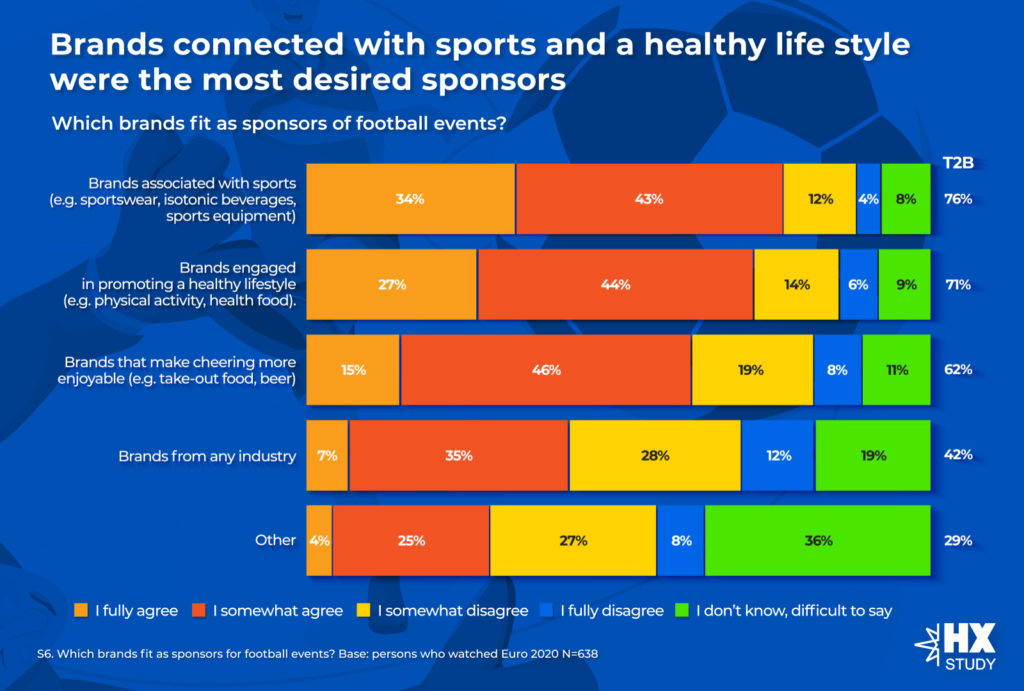
And how did Poles cheer?
In a pre-test conducted on the last weekend before the start of the tournament, as many as 20% of Poles declared that they would watch matches in bars. We compared Poles’ plans with the answers in the post-test, which was conducted after the championships. We took matches with the highest audience under consideration, i.e. the Polish matches and the final match. In both cases the most popular place to watch football matches was at home, with bars indicated by only a few percent of respondents. As you can see, the reality turned out to be more prosaic. However, the struggles of Polish football players were an opportunity to share impressions, as almost 1/5 of fans left home and watched the game at friends’ houses, and this happened more than 3 times more often than in the case of the final match. It should be noted that also in this case the plans before the beginning of Euro 2012 were more enthusiastic, as in the pre-test almost half of Poles declared their intention to watch the broadcast at friends’ houses.

Since we most often watched the matches at home, it is not surprising that the group of viewers was small, and that we were most often accompanied by our husbands, wives or life partners. This gives a slightly different profile of a “typical football fan” than could be inferred both from the fans’ plans for the upcoming Euro 2012 and from the commercial breaks adjacent to the European Championships. The fan from the spot is usually the life of the party, among friends, crowds, in a bar, at a stadium. An ordinary person, sitting in front of his or her television set, may feel that he or she is missing out on something. Meanwhile, it turns out that it is he who watches broadcasts from his own couch is the most typical representative of Polish football fans. The post-covid reality turned out to be less entertaining than one might expect. After the World Cup, Polish fans’ confidence in the safety of supporting together in open spaces also declined. As recently as June, 60% said it was safe to be in such zones, but after the tournament only 46% said it was safe – a drop of 14pp. These responses coincided with another wave of illnesses that had just begun to rise in other European countries, so the greater caution of those surveyed may be a reflection of the changing global situation.
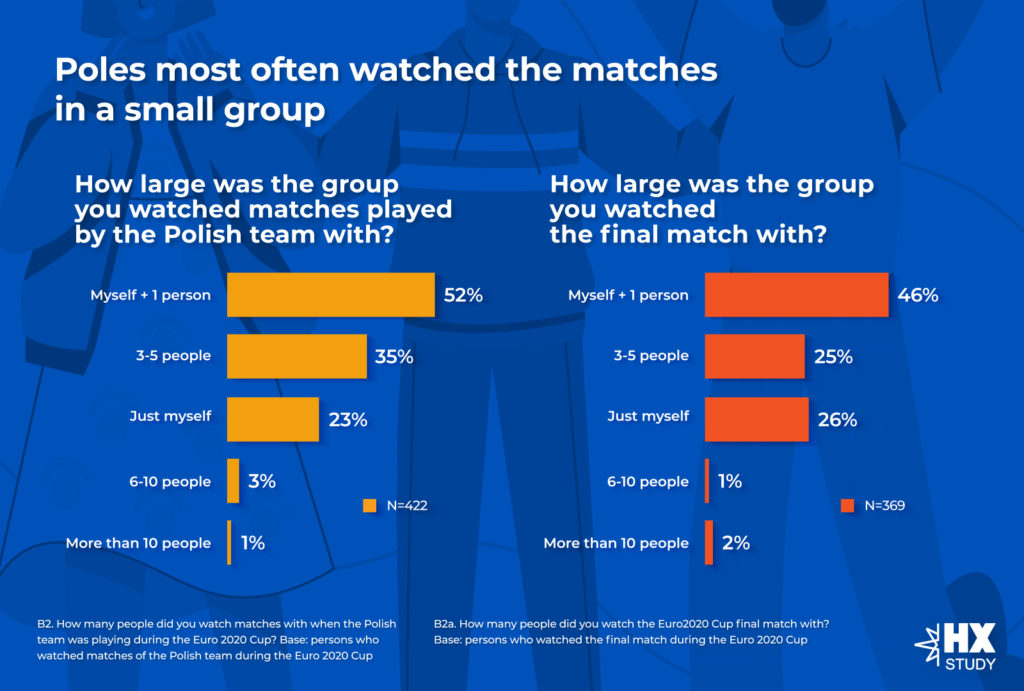
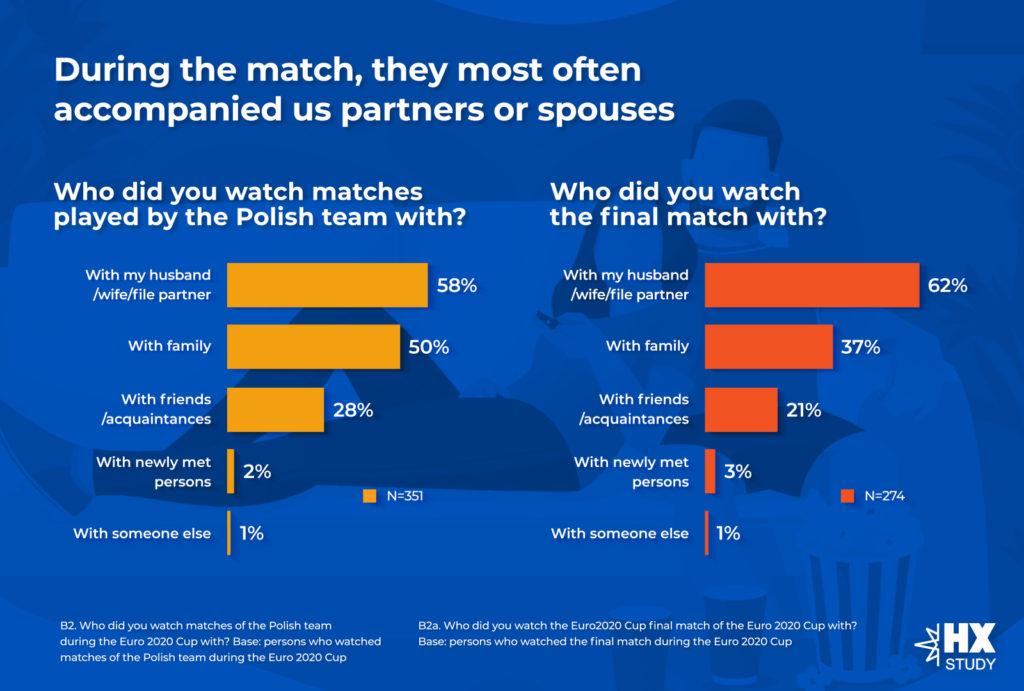
Fan shopping
If we imagine that a football fan runs to a local store 15 minutes before a match to buy something to drink and a quick snack at the last minute then we are wrong. From the responses of our respondents a picture of well thought out shopping emerges. Most people said they shop a few hours before the game, on the day of the event. The next largest group of respondents are those who shop even a few days in advance. The local store came in only third place, followed by the supermarket and discount store. When planning an advertising campaign, one can therefore assume that the ‘shopping moment’ lasts much longer than just a few minutes in the immediate vicinity of the matches. Of course, the context of the Euro is extremely valuable in terms of image, but the sales effect can also be achieved over a wider time range.
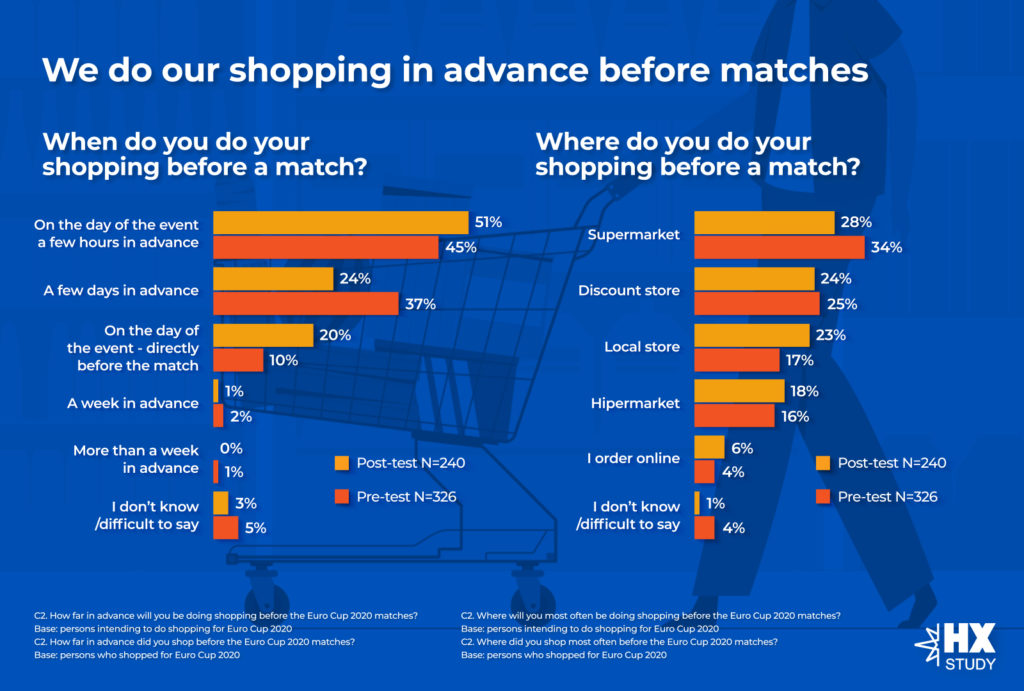
In stores we had a huge selection of products bearing the logo of the Euro. In the HX Study 27% of Poles confirmed that they had bought a product with a Euro 2020 logo, and 17% said they had bought a product with a gadget/gratis associated with the EURO Championships. From the number of indications it would seem that it is not that easy to persuade the Polish consumer to choose a specific brand. So let’s take a closer look at what Poles choose when getting ready to cheer.
It comes as no surprise that beer is the brand most often chosen to match. Alcoholic beer is an unquestionable leader of purchases (65%), but non-alcoholic beer was chosen by as many as 33% of respondents. Much fewer people than declared before the championships chose strong alcohol and fruit juices or nectars.
It is interesting that over half of Poles declare that they choose their favourite brand when it comes to beverages. Let’s remember that we operate in a highly competitive category and such responses suggest that long-term brand communication is important. Among other reasons for choosing beer already on the store floor, respondents mentioned chilling in the fridge and price promotions.
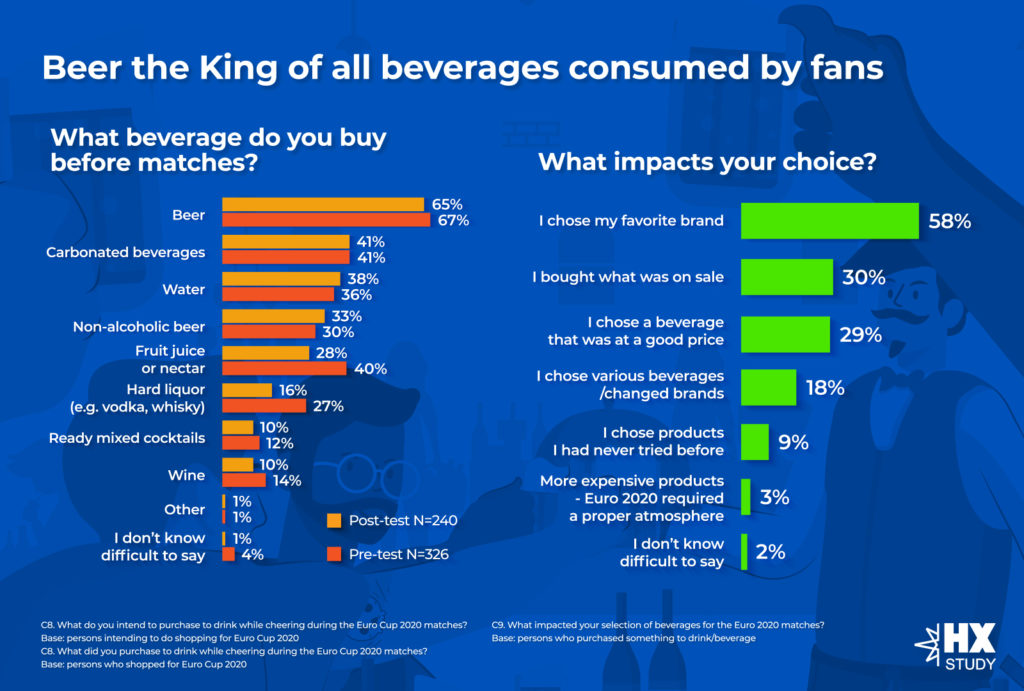
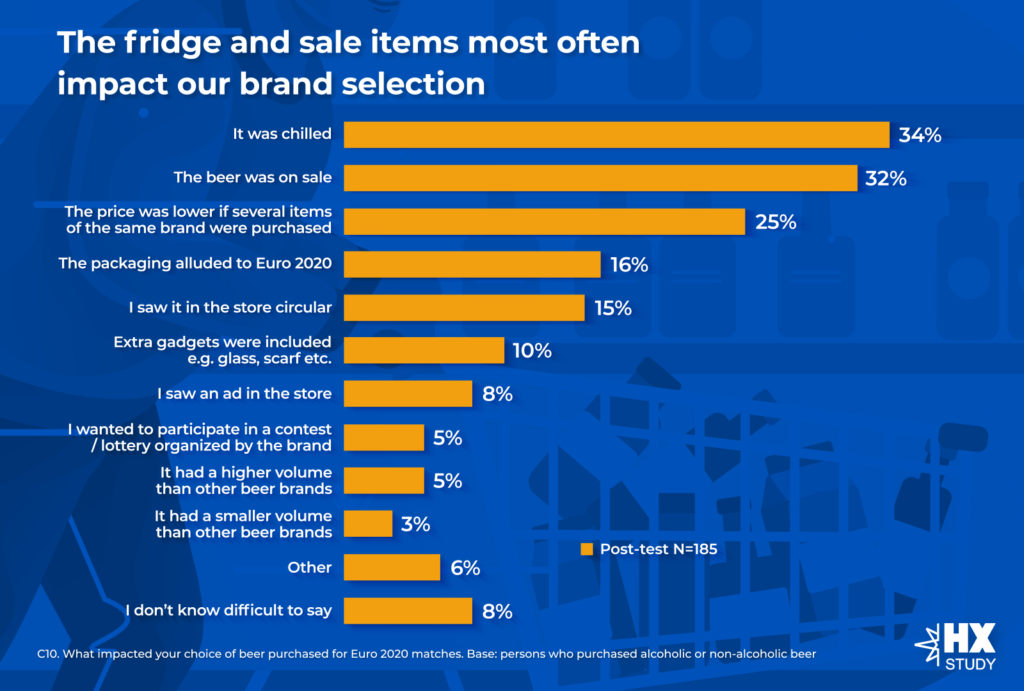
Apart from beer, an indispensable attribute of a football fan, we checked if the fans of the European Championships ordered take-out food. Before the games, 20% of fans declared such an intention, while after the Euro 2012 the number of people who indicated that they ordered food had doubled. The most popular website turned out to be pyszne.pl, whose popularity increased significantly during Euro 2012. Both the group who used the portal increased in relation to the people declaring such an intention in the pre-test, but let’s also remember that the level of indications of the pyszne.pl portal as a sponsor of Euro 2012 increased after the championship from 6% to 16%. We assume that it was the sponsorship presence during the tournament that translated into spontaneous use of the platform. We hear about changing culinary habits of Poles not only in the context of ordering food for matches. A time of pandemonium and confinement to homes has contributed to a significant uptake in ordering take-out food. Restaurants, despite being open now, say outright that they have customers mainly on weekends, and Poles have switched to ordering take-out food.
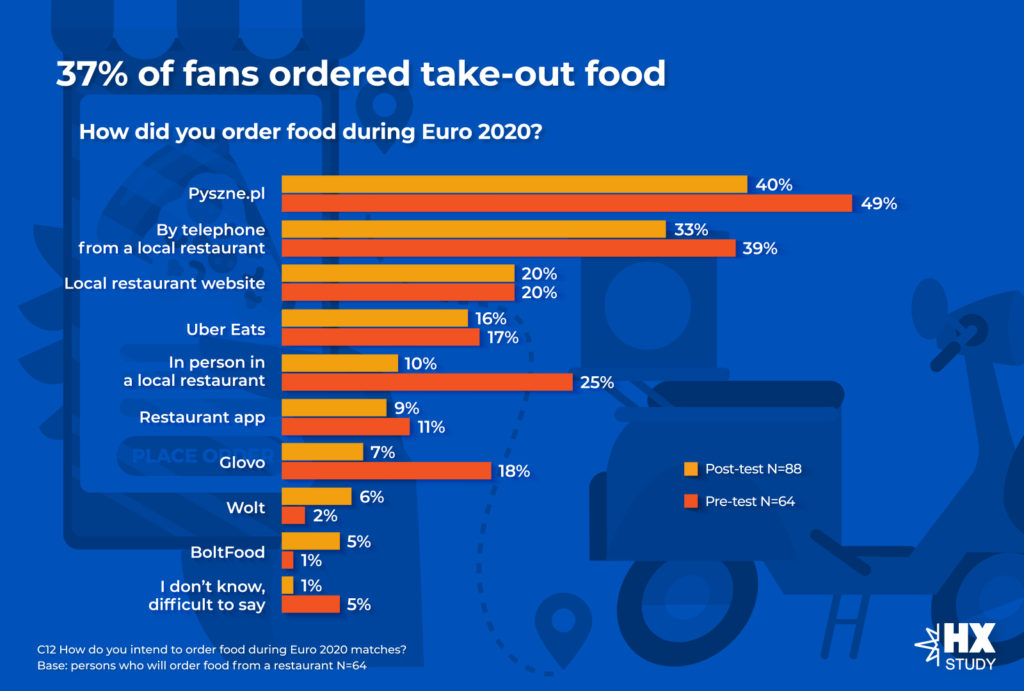
After the end of this year’s tournament we are left with many questions. Analyzing the plans of Poles, surveyed in a pre-test before the Euro started, a picture of fans eager for sports events and socializing emerged.
They planned to go out and watch together in a wider group. Now that the tournament is over, we are seeing declining viewing figures and intimate home supporters. The fan has changed and the way of experiencing sports events has changed. Questions have been raised as to whether it may be time to change the format of such events. Apart from the uniqueness of the pandemic period, another aspect is the different needs of the new generation of fans. Young people find it difficult to maintain their attention on formats exceeding one hour. Perhaps this will translate into changes in such inviolable dimensions as the duration of matches. We will eagerly observe what conclusions UEFA will come to and what they will offer us in the years to come.

.

